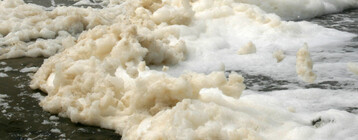Town To Issue Advisory On PFAS In Sea Foam Despite Potentially Unreliable Testing Results
JohnCarl McGrady •

With one exception, water samples collected from 21 Nantucket beaches and ponds show little to no PFAS contamination, with samples containing less than 20 parts per trillion (ppt) of all of the so-called “forever chemicals.”
Samples collected from sea foam yielded much higher PFAS concentrations, though the reliability of the results is uncertain, and the reported concentrations may be inflated.
According to a presentation at Thursday’s Board of Health meeting, no PFAS was detected at nine of the 21 surface water sampling locations, and samples from nearly all other locations had relatively little PFAS.
“Every reported result from our surface water samples fell below that screening value, indicating that no action was required and the water is considered safe for swimming,” Dr. Rebecca DeVries, a vice president at Eastern Research Group, the consulting firm hired by the town to help design, sample, and analyze the data, said.
Still, as experts have emphasized at recent Board of Health meetings, there is no safe level of PFAS contamination, meaning even the low levels detected in Nantucket’s surface water could be cause for concern.
Additionally, one sample from Sconset Beach initially tested at over 210 ppt for a single PFAS, far above the established safety screening value of 20 ppt. However, the sample was contaminated with large amounts of red algae. When another sample was collected from the same location, the PFAS concentration was much lower.
“This sample was somewhat unique compared to others because it contained a large amount of red algae. It was basically unavoidable when we were collecting the sample. But given the result and uncertainty, we re-sampled this location about two weeks ago. During that re-sampling event, environmental conditions were quite different, and there was minimal algae present,” DeVries said. “Only one PFAS compound was detected, and at a low level.”
The high level of PFAS detected in just one sample could suggest that it was the algae that was contaminated, not necessarily the water itself.
“Within the jar, there was a lot of algae mixed in,” DeVries said. “It could be that it was tied up, bound to the algae in some way that we can’t make a lot of sense of.”
Foam samples collected from Madaket Harbor and Sesachacha Pond turned up far higher PFAS levels, in one case up to 30,000 ppt for a single PFAS compound. These results would be the highest levels of PFAS ever detected on Nantucket. Still, the lab that conducted the testing noted that many of the samples were unreliable and the tests should not be considered accurate. The actual levels of PFAS in Nantucket’s foam could be different from what the tests showed.
“Many of the results, in fact, all of the results from Sesachacha Pond, were qualified by the laboratory as not meeting their quality assurance criteria,” DeVries said. “This was largely because there was not sufficient volume in the sample.”
At this point, the health impacts of the contaminated foam are unclear.
“While we know PFAS are present, and likely at these higher levels, we aren’t certain of the exact concentration,” DeVries said. “Some of those qualifiers from the lab do indicate that the results could be biased high, so I just think that’s something to keep in mind.”
Still, the Town is treating the high PFAS levels detected in Nantucket’s foam seriously.
“We will be issuing a foam advisory…encouraging residents to not contact the foam,” Nantucket’s Environmental Contamination Administrator Andrew Shapero said. “And that’s out of an abundance of caution, given those high PFAS levels.”
There is no existing health guidance on PFAS in foam.
PFAS has emerged as a significant threat to Nantucket’s water quality, with contamination detected at high levels across the island, often in unexpected areas. Until now, however, almost all of the available data was from groundwater, not surface water at the island’s beaches and ponds.
A second round of sampling is planned for late August.
At the same meeting, Shapero gave an update on ongoing initiatives to test Nantucket’s well water for PFAS. A home on Oak Hollow Lane, in a known hotspot for PFAS, tested at 467 ppt, well above the 90 ppt imminent hazard threshold set by the Massachusetts Department of Environmental Protection. That’s the highest PFAS concentration of any well tested in the area, far higher than several other recent imminent hazard detections in the vicinity.
The source of the PFAS contamination in the area remains unknown. It is also unclear why some homes in the same neighborhood have virtually no PFAS in their well water, despite being mere feet from levels over five times the imminent hazard threshold.
Shapero also reported on the results of 39 PFAS tests carried out by the town. Twenty-seven were non-detects, 11 came back below the state’s 20 ppt public drinking water standard, and one, on Corby Way off Bartlett Road, exceeded the standard.
Used to manufacture stain- and water-resistant products, the family of chemicals known as PFAS is suspected to increase the risk of kidney and testicular cancers, as well as other health conditions. They are often called "forever chemicals" because they do not break down and remain present in the environment. The chemicals are used in a wide range of products, from non-stick pans to fast food wrappers to firefighting foam.